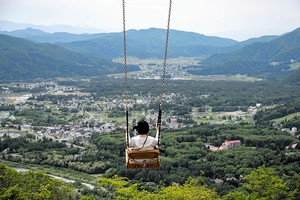By LISA VOGT/ Special to Asahi Weekly
January 9, 2024 at 07:00 JST
 Buildings from the Jomon Pottery Culture Period have been reconstructed at the Sannai Maruyama archaeological site. Among them is an observation tower supported by large wooden pillars. Visitors can experience the village as it was in the past and many valuable excavated items can be seen in the exhibition room. (Photo by Lisa Vogt)
Buildings from the Jomon Pottery Culture Period have been reconstructed at the Sannai Maruyama archaeological site. Among them is an observation tower supported by large wooden pillars. Visitors can experience the village as it was in the past and many valuable excavated items can be seen in the exhibition room. (Photo by Lisa Vogt)
After stating “indisputable” (really?) facts such as “Japan has four seasons” or “It’s because Japan is an island nation,” the narrator on Japan Broadcasting Corp.’s popular program “Chico chan ni shikarareru” asks the audience, “Now, I ask all Japanese citizens...” (“Imakoso subete no Nihonkokumin ni toimasu...”), and people are stumped and grope for an answer to the question.
All Japanese citizens? I’m not, but the beginning of the query makes several big virtual question marks hover 10 centimeters above my head.
I wonder how many times I’ve heard a comment along the lines of “You Americans are ‘shuryo-minzoku’ (hunting people). We Japanese are ‘noko-minzoku’ (agricultural people), and that’s why ...”
Well, I hate to remind Japanese of this, but the Jomon Pottery Culture Period (c. 14500 B.C.-1000 B.C.), which continued for over 10,000 years, was predominantly hunter-gatherer.
The Sannai Maruyama archaeological site in Aomori Prefecture contains the ruins and reconstruction of a massive Jomon Period settlement.
In 1992, when digging up the land to build a baseball stadium, the scale and significance of the site were revealed. In 2021, it became one of the Jomon Prehistoric Sites in Northern Japan, a UNESCO World Heritage Site.
I had wrongly assumed hunter-gatherer cultures comprised small, unsophisticated groups of nomadic people.
Sannai Maruyama is a whopping 42-hectare village (as large as nine Tokyo Domes) consisting of more than 600 dwellings, a 32-meter post-in-ground longhouse that could house 300 people for meetings and ceremonies, a three-story, six-pillar tower made with straight cultivated chestnut wood pillars each measuring 1 meter in diameter, roads and graves.
Archeologists have found holes with roots of burned chestnut trees that must have served as pillars for 15-meter-high structures and excavations are ongoing.
Tools, masks and jewelry such as jade pendant heads that probably came from Niigata Prefecture about 600 kilometers away and amber products, perhaps from Iwate Prefecture, have been unearthed, suggesting trade with far-away groups.
Of course, countless pieces of “Jomon,” meaning “cord-marked,” pottery have been found, in addition to skillfully created lacquerware.
I enjoyed seeing huge pots with scorch marks at their base, which tells us the inhabitants enjoyed hot stew.
Meat from duck, pheasant, rabbit, deer, wild boar, shrimp, fish, clam, squid and octopus from Mutsu Bay, along with nuts, berries and mountain vegetables, was no doubt savored.
Now I ask everyone, not only Japanese citizens, this question: Is “because we are an agricultural people” (“noko-minzoku dakara”) the real answer to the question, whatever it may be?
***
This article by Lisa Vogt, a Washington-born and Tokyo-based photographer, originally appeared in the Oct. 29 issue of Asahi Weekly. It is part of the series "Lisa’s UNESCO World Heritage Sites in Japan," which depicts various parts of the country through the perspective of the author, a professor at Aoyama-gakuin University.




















A peek through the music industry’s curtain at the producers who harnessed social media to help their idols go global.
A series based on diplomatic documents declassified by Japan’s Foreign Ministry
Here is a collection of first-hand accounts by “hibakusha” atomic bomb survivors.
Cooking experts, chefs and others involved in the field of food introduce their special recipes intertwined with their paths in life.
A series about Japanese-Americans and their memories of World War II